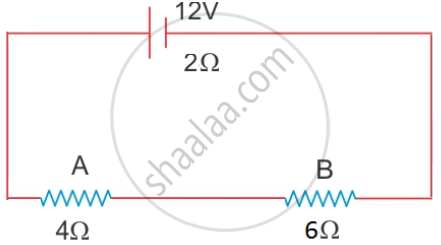Advertisements
Advertisements
प्रश्न
State the relation between potential difference, work done and charge moved.
उत्तर
The potential difference between two points in an electric circuit is equal to the amount of work done in moving a unit charge from one point to another point.
`"Potential difference (V)"="Work done (W)"/"Quantity of charge moved (Q)"`
APPEARS IN
संबंधित प्रश्न
A battery of emf 12 V and internal resistance 2 Ω is connected with two resistors A and B of resistance 4 Ω and 6 Ω respectively joined in series.

Find:
1) Current in the circuit
2) The terminal voltage of the cell
3) The potential difference across 6Ω Resistor
4) Electrical energy spent per minute in the 4Ω resistor.
Name the law which relates the current in a conductor to the potential difference across its ends.
Keeping the potential difference constant, the resistance of a circuit is doubled. By how much does the current change?
Write down the formula which states the relation between potential difference, current, and resistance.
A p.d. of 10 V is needed to make a current of 0.02 A flow through a wire. Wire p.d. is needed to make a current of 250 mA flow through the same wire?
A current of 200 mA flows through a 4 kΩ resistor. What is the p.d. across the resistor?
Calculate the power used in the 2 Ω resistor in each of the following circuits: a 4 V battery in parallel with 12 Ω and 2 Ω resistors.
Explain the analogy between the flow of charge (or current) in a conductor under a potential difference with the free fall of a body under gravity.
Define the following:
Potential difference
